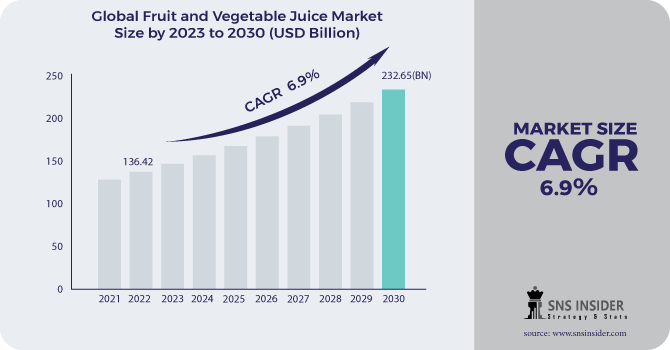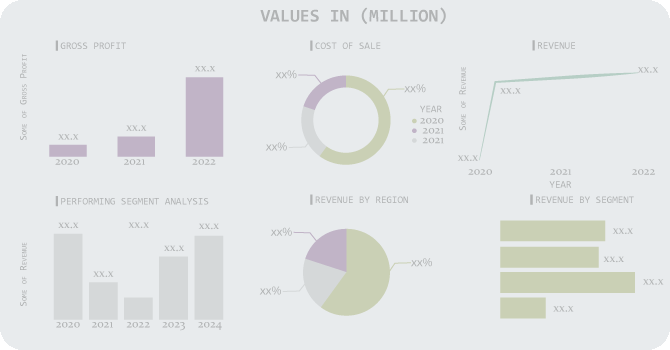Fruit and Vegetable Juice Market Report Scope & Overview:
Fruit and Vegetable Juice Market Size was valued at USD 136.42 billion in 2022 and is expected to reach USD 232.65 billion by 2030 and grow at a CAGR of 6.9% over the forecast period 2023-2030.
The Fruit and Vegetable Juice market hold a significant piece of the Global drink industry. The Fruit and vegetable juice market is requesting a section of the refreshment industry because of the rising mindfulness and inclination of customers for solid items. The market is supposed to fill in the emerging nations. The products of the soil juice market are fragmented by sort of the significant natural product/vegetable fixing utilized, a grouping of the juices, classification served by the juice, and geology. The market relies upon the geological dissemination and accessibility of the organic product/vegetable and the wellbeing contemplations.

The Global Fruit and Vegetable juice industry is the most cutthroat section of the drink industry. The market is driven by the shopper’s interest in solid items. The interest is likewise determined by the pervasive customer pattern and the tendency for a juice. Item advancement and mixes are presented in the market according to the buyer’s interest. The significant danger or limit in the market is assorted squeezes and flavor inclinations among the buyers. Understanding the buyer’s necessity and amazing open doors in the market against the difficulties is a significant technique to support on the lookout.
Organic product juice and vegetable juice are the swaps for carbonated beverages and caffeinated drinks. Shoppers are well-being cognizant and lean toward natural product juice more than some other kind of drink accessible on market. Purchasers changing way of life has made natural product juice as the piece of their day-to-day diet. Juice-making organizations are zeroing in on adding additional nutrients and minerals as per purchasers changing tastes and inclinations and requests.
Market Dynamics:
Driving Factors:
-
The rising interest for sound refreshments from an inexorably wellbeing cognizant buyer base.
-
The developing notoriety of cold-squeezed juices.
Restraining Factors:
-
Various squeeze and flavor inclinations among the purchasers.
Opportunities:
-
Regard for one's well-being and wellness has turned into an imperative viewpoint.
-
There has been a dormant change in the utilization of solid juices from circulated air through pop.
Challenges:
-
High sugar content in bundled juices, combined with the expansion in medical issues like diabetes and weight.
Impact of Covid-19:
During the continuous COVID-19 pandemic, products of the soil juices utilization have expanded around the world by its medical advantages. This was a result of the way that buyers became mindful of their well-being. There was an adjustment in purchasing conduct of the customers. Because of the terminations of specific retail locations, the online business sites were significantly liked by the customers, as the shoppers were amassing the juice of the leafy food for in-home utilization. The Coca-Cola Company, which is a central part of this section, reported that during the pandemic, the organic product drink Maaza had a larger number of deals than the carbonated beverages. As indicated by the organization, this fast change was because of the customers changing inclinations toward the beverages.
Product type:
Based on items, the worldwide market has been additionally isolated into organic product juices, organic product and vegetable mixes, and vegetable juices. The portion is supposed to keep up with its strength in any event, during the conjecture time frame. Natural product juices are accessible in a wide assortment going from citrus organic products to tropical natural products. The rising inclination for high nutrient and mineral substance refreshments is supposed to fuel the portion development over the figure period. These are normally mixes that comprise a combination of vegetable and natural product juices giving wholesome characteristics to both.
Distribution Channel:
The stores/hypermarkets fragment drove the market and represented the biggest income share. Grocery stores assist brands with remaining customer-centered by offering items that shoppers need. The accessibility of a wide scope of items with different rebate offers makes them one of the most favored conveyance channels by shoppers. The web-based dispersion channel fragment is expected to enroll the quickest CAGR. Amazon saw an emotional expansion popular on various fronts, including staple things, all through 2020.
Key Market Segmentation:
By Product Type:
-
Fruit Juice
-
Vegetable Juice
-
Fruits and Vegetable Blends
-
Nectar
By Distribution Channel:
-
Supermarkets and Hypermarkets,
-
Convenience Stores
-
Specialty Stores
-
E-Commerce
-
Others
.png)
Regional Analysis:
-
North America
-
USA
-
Canada
-
Mexico
-
-
Europe
-
Germany
-
UK
-
France
-
Italy
-
Spain
-
The Netherlands
-
Rest of Europe
-
-
Asia-Pacific
-
Japan
-
south Korea
-
China
-
India
-
Australia
-
Rest of Asia-Pacific
-
-
The Middle East & Africa
-
Israel
-
UAE
-
South Africa
-
Rest of the Middle East & Africa
-
-
Latin America
-
Brazil
-
Argentina
-
Rest of Latin America
-
North America represented the biggest offer. The district has been seeing high item interest. Expanding utilization of juices as a staple breakfast item is supposed to support the market in the locale throughout the next few years. Significant market players in the U.S. are presenting new items focused on the well-being and cognizant customers. The natural product juices fragment is one of the famous sections in Asian nations; hence, makers are quick to catch this market by sending off new items in this classification. The new items are particularly designated for customers looking for better options in contrast to carbonated refreshments.
Key Players:
The Coca-Cola Company, PepsiCo Inc., Fresh Del Monte Produce Inc., Dr. Pepper Snapple Group, Hershey, Grimmway Farms, Welch Food Inc., Ocean Spray, Golden Circle, Dole Packaged Foods, LLC.
PepsiCo Inc-Company Financial Analysis

| Report Attributes | Details |
|---|---|
| Market Size in 2022 | US$ 136.42 Billion |
| Market Size by 2030 | US$ 232.62 Billion |
| CAGR | CAGR 6.9% From 2023 to 2030 |
| Base Year | 2022 |
| Forecast Period | 2023-2030 |
| Historical Data | 2020-2021 |
| Report Scope & Coverage | Market Size, Segments Analysis, Competitive Landscape, Regional Analysis, DROC & SWOT Analysis, Forecast Outlook |
| Key Segments | • by Product Type (Fruit Juice, Vegetable Juice, and Nectar) • by Distribution Channel (Supermarkets/Hypermarkets, Specialty Stores, Convenience Stores, Online Retail Stores, and Other Distribution Channels) |
| Regional Analysis/Coverage | North America (USA, Canada, Mexico), Europe (Germany, UK, France, Italy, Spain, Netherlands, Rest of Europe), Asia-Pacific (Japan, South Korea, China, India, Australia, Rest of Asia-Pacific), The Middle East & Africa (Israel, +D11UAE, South Africa, Rest of Middle East & Africa), Latin America (Brazil, Argentina, Rest of Latin America) |
| Company Profiles | The Coca-Cola Company, PepsiCo Inc., Fresh Del Monte Produce Inc., Dr. Pepper Snapple Group, Hershey, Grimmway Farms, Welch Food Inc., Ocean Spray, Golden Circle, Dole Packaged Foods, LLC. |
| Key Drivers | •The rising interest for sound refreshments from an inexorably wellbeing cognizant buyer base. •The developing notoriety of cold-squeezed juices. |
| Market Opportunities | •Regard for one's well-being and wellness has turned into an imperative viewpoint. •There has been a dormant change in the utilization of solid juices from circulated air through pop. |

